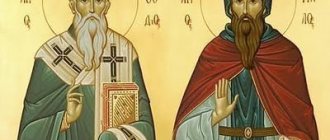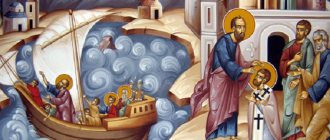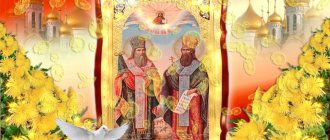Heretics, as long as Christianity has existed, have poisoned the lives of pious ascetics of the church. Many saints suffered from their evil tongues and the hatred bubbling in their rotten souls, but still did not deviate from their own convictions. Representatives of the clergy especially suffered from those carrying heresy. A similar fate did not spare the Archbishops of Alexandria, Athanasius and Cyril, whose memorial day the church celebrates annually on January 31.
Afanasy's childhood
The future Saint Athanasius was born around 297 in Alexandria. His family strictly adhered to Christian dogmas, so the boy grew up in an atmosphere of piety and virtue. It is not surprising that from early childhood he had a love for worship. Moreover, the boy preferred playing priest to ordinary children's entertainment, organizing this action together with his peers, who were also raised in Christian families. Often children of the pagans joined them, but no one persecuted the children of opponents of the Jesus faith.
Why I love my robot vacuum cleaner so much: sharing my own experience
On the contrary, Athanasius tried to convey the word of God to such children, talking about life and service to people and God the Savior. He converted the youths who believed to Christianity, performing the rite of Baptism on them.
Young Athanasius developed such a zealous and at the same time reverent attitude towards God and the church topic in general, including under the influence of his mother’s actions. She brought her son to the temple to St. Alexander, Patriarch of Alexandria, thus dedicating him to the Lord.
The role of Saint Cyril in Christianity
Saint Cyril (in the world Constantine) lived with his brother Methodius in the 9th century in Thessaloniki - a city in which two cultures lived simultaneously - Slavic and Byzantine. Subsequently, the brothers became one of the most famous and significant figures in the history of Russia, because they were the first to compile the Slavic alphabet and translate the Bible into the Slavic language.
Icon of Saints Equal to the Apostles Cyril and Methodius
The mission of both brothers was to bring Christianity to people through the translation of sacred texts into the Slavic language . They had to travel a lot and endure many hardships, as a result of which Cyril (then Constantine) became seriously ill and took the schema just before his death.
Which churches have an icon of the saint?
The icon of St. Cyril is kept in churches in countries such as the Czech Republic, Macedonia and Bulgaria. All of these iconographic images date back to the 19th century, with the oldest of them being painted in 1893. This icon is located in the Church of St. Basil the Great, which is located in Talitsa.
Also, the image of St. Cyril is presented on the southern aisle of the Church of the Apostles Peter and Paul in St. Petersburg. Some churches in Moscow also have icons of this saint.
The icon of St. Cyril was painted several times and on each of the icons he is represented differently. On earlier icons, Saint Cyril is depicted in the clothes of a monk with a scroll in his hands; according to some sources, this is the Holy Scripture, according to others, the alphabet. Earlier icons represent the image of St. Cyril differently - with his right hand he blesses the believers, and in his left he holds a scroll.
How an icon protects
We often hear that people seek protection from some “strong” icons. This formulation is incorrect, because help and strength come not from the icon itself, but from the Lord God. We pray before the image, but not to the image itself. The icon that was not consecrated in the church is more of an interior item. When talking about the help of an icon in any matter, you need to understand that what helps, first of all, is sincere faith in what you are praying for.
Icon of Saint Cyril Equal to the Apostles
This means that if there is no faith in the heart for help from above, then no appeal to the holy image will help. Here it is appropriate to mention the well-known idea that it seems to a person that God is watching his external actions, but the Lord sees, first of all, a person’s heart.
Read about icons of other Orthodox saints:
- Icon of Saint Stylian of Paphlagonia
- Icon of Saint Daniel of Moscow
- Icon of Saint Demetrius of Thessalonica
Spiritual activity of Saint Athanasius
At the age of 21, the ascetic was ordained to the rank of deacon by his mentor. This is where the clash between the future archbishop and heresy began. Athanasius observed, not without sorrow, the situation developing in the Church. Converts to the faith of Jesus did not possess desirable qualities, such as piety, virtue, and humility. On the contrary, their entire existence and service in the temple was aimed at achieving selfish goals - fame, high priestly ranks. These people continued to observe pagan customs.
One of these heretics, Arius, laid the foundation for a new false teaching: Arianism, whose followers called themselves Arians. He taught to live for one’s own pleasure, heaped abuse on Jesus and the Mother of God, and placed Man above God. This heresy became widespread, but Saint Athanasius tried to fight it. In 325, the ascetic publicly spoke out against Arius at the Council of Nicaea. A year later, having become a bishop after the death of the Patriarch of Alexandria, he continued the good work, using all his strength, using new powers.
Such zealous resistance to the new false religion caused an uprising of Christians, unstable in their faith. Saint Athanasius became the object of slander. Heretics entwined the imperial court like snakes. Taking advantage of the soft-heartedness of the then ruler Constantine the Great, they continually informed the emperor about the saint. Afanasy had to leave the city and hide for a long time. True, his friends did not leave him without support: the holy monks Pachomius and Anthony.
The malice of the heretics, alas, did not subside. Afanasy endured many sorrows from them, but everywhere he emerged victorious, he refuted all accusations against him, presenting evidence of his own innocence.
However, this did not help. It got to the point that the imperial court took the side of the Arians. The ruler at that time was already the son of Constantine the Great, Constantius. Terrible Christian persecutions began, and Saint Athanasius was forced to take refuge in Rome for 3 years.
In the end, God punished the wicked. The saint returned to Alexandria under Emperor Valens, who gave the go-ahead to the ascetic to take up his former position as bishop. In total, Afanasy served in this rank for 46 years. He passed away on May 2, 373, at the age of 76.
PORTAL CONTACTS
On January 31 (January 18, old style), the Orthodox Church celebrates the memory of Saints Athanasius (c. 295-373) and Cyril (between 370-380-444) of Alexandria. This celebration was established in Constantinople.
Saints Athanasius and Cyril are known primarily for their struggle against distortions of Orthodox doctrine. In the hymns dedicated to the saints, we can hear the following words: “Thou hast endured persecution and endured troubles, O God-speaking Reverend Athanasius, until now thou hast driven away the flattery of the godless Ariev, and thou hast saved thy flock from wickedness, having dogmatized the Son and the Spirit of the One Consubstantial with the Father, in a sacredly all-blessed manner. " and " You drove away the mental wolves from the Church of Christ, Cyril, with the rod of your teachings, and you protected this word of affirmation around this and presented it to Christ, the immovable and unshakable. Pray to him to deliver from aphids and troubles by faith, who honor your memory.”
The main heresy (heresy is an erroneous teaching that distorts the foundations of the Orthodox faith) of the 4th century was Arianism. The Alexandrian presbyter Arius, who had great authority among the Christian population of the city, thanks to his ascetic lifestyle and preaching talent, expressed the opinion that the Son of God is the creation of the Father. Arius stated that "there was a time when the Son was not." On the one hand, Arius says that the Son was born “before time,” but on the other hand, the Son did not exist before His birth. This idea becomes quite understandable in the context of Arius’ understanding of the doctrine of God’s creation of the world. From the point of view of the Alexandrian presbyter, God first gives birth to the Son, “calls Him the Word,” and only then, through the mediation of the Son-Logos (or through Him), creates the world. The Son of God acts as a mediator in the creation of the world by God. Arius explains this by saying that the world could not “accept upon itself the unmoderable Father’s hand and the Father’s creative power.” Thus, between the eternal and one uncreated and unborn God the Father and the created world, the Son created by God before the world comes into being.
Arius also identified the concepts of “birth” and “creation”. Even when it came to the birth of the Son by the Father, Arius and his supporters understood this as an indication of the creation of the Son. The Arians believed that if God really gave birth to the Son, then there would be a division in God, because God must in this case give part of His essence to the Son. In this case, it was necessary to recognize either the possibility of division in God (and therefore a change in the essence of God) or to recognize the existence of two equal Gods - the Father and the Son (which, from the point of view of the Arians, was obvious polytheism unacceptable in Christianity).
The ideas of Arius caused such a great resonance in the Church that, to consider them, Emperor Constantine I the Great convened a meeting of bishops of the entire Church in 325, later known as the First Ecumenical Council in Nicaea (Nicaea is the city where the meetings of the council were held). Saint Athanasius, then still a deacon and assistant to Saint Alexander of Alexandria, whose successor at the episcopal see he later became, was also present at this council. Since then, Saint Athanasius has become the most brilliant and irreconcilable fighter against Arianism. To silence the saint, his opponents used even the most dishonest methods and accusations. But it was the faith of Athanasius that became the faith of the entire Church.
What was the danger of Arianism and why did St. Athanasius and many other Church Fathers condemn this heresy? Firstly, the Arians rejected the belief in the unity of the Holy Trinity. Only God the Father was God in the proper sense; the Son and the Spirit were given a place, although higher, but still creations. Secondly, the doctrine of the Son of God as a created being entailed the idea of His changeability (only the eternal God is unchangeable) and the possibility of choosing evil (if the Son is one of the creations, then He can also be subject to evil, like all creation) . But God knew by foreknowledge that the Son would preserve His good and sinless will, therefore, through the Son the world was created and salvation was accomplished.
All this was a serious distortion of the Christian faith. On the other hand, the errors of Arius became the reason for the development of more precise theological terminology and a detailed explanation of the most important aspects of the doctrine.
Saint Athanasius, as already mentioned, became the leader of the opponents of Arianism and the defenders of the Orthodox faith. He devoted his entire life to the approval and explanation of the statement of faith adopted at the First Ecumenical Council, directed against the Arian false teaching. The Creed of the First Ecumenical Council read: “We believe in One God, Father, Almighty, Creator of all things visible and invisible. And in the One Lord Jesus Christ, the Son of God, begotten of the Father, the Only Begotten, that is, from the essence of the Father , God from God, Light from Light, true God from true God, begotten, uncreated, consubstantial with the Father <...> And in the Holy Spirit < …>". The words highlighted in the test of the Creed were the main anti-Arin clarifications. The Son of God was born from the essence of the Father, that is, he was not created from nothing, like the rest of the world, but was born. It is important to remember that the term “birth” is an indication of the relationship between the Father and the Son (it remains hidden from us exactly how birth from the essence occurs; we know how a person gives birth to a person, but we cannot know and comprehend how the eternal God gives birth to the eternal Son) . God creates the world out of nothing, so the world begins in time (the world is not eternal, and the essence of the world is different from the Divine essence). God gives birth to the Son in eternity from his own essence. Therefore, the Son is as eternal as the Father and has the same essence as the Father, that is, he is consubstantial with the Father. The Father's birth of the Son from essence does not entail division in God or diminishment of the Father's divinity. This is the secret of Divine existence: God is one in three persons - Father, Son and Holy Spirit. The term "consubstantial" is a reference to the equality of the Father and the Son, to equal divinity and glory. For the Arians, these terms were unacceptable, because the reference to “the birth of the Son from the essence of the Father” crossed out the Arian identification of the concepts of creation and birth. And the term “consubstantial” logically required the recognition of the equality of the Father and the Son, which knocked out the basis from under the main Arian idea.
Defending the doctrine of the consubstantiality of the Father and the Son, Saint Athanasius also gives another argument, which without a doubt can be called the most important. It is interesting that even before the start of the Arian disputes, the future saint wrote a treatise that contained ideas that very accurately expressed the Christian faith in the Son of God as the true God and Savior and were unacceptable for the Arians. This work is called “The Word on the Incarnation of God the Word.” It answers the question “why did God become a man?” Saint Athanasius writes: “It (the Word) became man, so that we might become deified.” This expression is also known in a slightly different form: “God became man so that man could become God.” That is, in order to save man, God Himself becomes man. Therefore, if the Son of God were not the true God (but would only be the highest creation), then the incarnation (God’s acceptance of human nature) would lose all meaning. Salvation and deification (becoming God) of the created world cannot be accomplished through a created being. Just from the point of view of the Arians, the opposite should be recognized: God saves the created world with the help of a created mediator. But Saint Athanasius, and with him the entire Church, initially believed in the salvation of the world by God Himself. The Son of God, being God, becomes one of us, so that we can all become like God. Of course, the created world cannot pass into the uncreated state, and man cannot change and become the essence of God. But according to the thoughts of St. Athanasius and other Church Fathers, a person can become a god “by grace”: overcome sin and death, gain immortality and eternal life. Man could not have accomplished this on his own, but this goal became feasible thanks to the incarnation, death and resurrection of the true God - the Son of God, the Lord Jesus Christ. The Son of God comes to us as a man to renew us and lead us to the Father. Thus, through faith in the Son of God and Savior, every person receives the opportunity of salvation and renewal or, as St. Athanasius writes, deification.
Saint Cyril of Alexandria lived later than Saint Athanasius, but occupied the same episcopal see. At that time, a new heresy arose in the Church, later called Nestorianism (after the name of its main exponent - Nestorius, Archbishop of Constantinople). The capital's Archbishop Nestorius expressed the opinion that the Virgin Mary should not be called the Mother of God, because she gave birth not to God, but to a simple man. That is, the simple man Jesus was born from the Virgin, in whom the Son of God dwelt, and that is why Jesus retained complete obedience to the Father. For Nestorius, expressions such as: God was born of a Virgin, God suffered on the cross and died... If God is born, suffers and dies, it means God is subject to change, which contradicts the belief in the eternal and unchanging God. Therefore, the unity of Christ was only visible. When pronouncing the word “Christ” one should mean separately God the Word and separately the man Jesus.
Opponents of Nestorius, and above all Saint Cyril of Alexandria, saw in this teaching a distortion of faith in the Incarnation of the Son of God. To put it quite simply, God the Word united with man in a spiritual sense, by grace, just as God unites and abides in the saints. Opponents of Nestorianism pointed out that the new teaching jeopardizes the Church’s faith in the true Incarnation: how could God save man if He Himself did not become a true man?
In his polemic with Nestorianism, Saint Cyril of Alexandria especially emphasized that God the Word did not “dwell” into man, but “became” man. That is, Jesus Christ, born of a Virgin, is the Son of God Himself, pre-eternally born by God the Father, and that is why we can say that the Virgin gave birth to God (and call the Virgin the Mother of God). If Nestorius made a clear distinction between the “temple” - Jesus born of the Virgin, and “who dwelt in it” - the Son of God, then St. Cyril speaks of the true unity of God and man in Christ: “One and the same God the Word is God and man.” , “Whoever does not confess the Word of God to those who suffered in the flesh, and to those who were crucified in the flesh, and to those who tasted death in the flesh, and became the firstborn from the dead (Col. 1:18 ), since He is life and life-giving, like God: let him be accursed.” Expressing his point of view, Saint Cyril used a theological formulation that belonged to the heretic Apollinaris, Bishop of Laodicea. Apollinaris was a contemporary and friend of Saint Athanasius of Alexandria, being also his associate in the fight against Arianism. Polemicizing with the Arians, Apollinaris wrote about “ the one incarnate nature of God the Word ” (the Arians denied the possibility of uniting the uncreated God with created man, so the idea of the Incarnation was also unacceptable to them), wanting to explain exactly how the Son of God is incarnated to save the world. Apollinaris sought to substantiate against Arian ideas the unity of God and man in Christ, necessary for salvation. But while fighting against heresy, Apollinaris himself fell into error: he believed that God the Word in incarnation takes only flesh, while God the Word takes the place of the soul. It turned out that the Son of God united only with a part of human nature, and did not become a man in the true sense.
Saint Cyril used the formulation of Apollinaris, but put a different meaning into it. Polemicizing with Nestorius, St. Cyril prefers to talk about “ one (single) nature of Christ .” But explaining this term, the saint writes that the humanity of Christ, which together with the deity constitutes this “single nature,” includes not only the flesh, but also the soul: “The body, united with the Word, was animated by an intelligent soul.” In another place the saint writes: “When the inspired Scripture says that He (the Son of God) suffered in the flesh, then we must speak in exactly the same way, that is, by human nature.” Thus, St. Cyril, speaking about the “one nature” of Christ, implies the unity of God and man in Christ, whereby God the Word becomes a man not only taking on human flesh, but also mind and soul. And it is through this closest unity that salvation is achieved. Therefore we can say that God was born as a man and died on the cross. God remains unchanged, but human nature becomes the nature of God the Word, therefore everything that Christ does as a man, He also does as God.
One can recall the answer of the Apostle Peter to Christ’s question to the disciples: Who do you say that I am? Simon Peter, answering, said: You are the Christ, the Son of the Living God (Matthew 16 :15-16). To whom is the Apostle Peter addressing – the man Jesus, in whom God abides, or the only incarnate Son of God, the Lord Jesus? Saint Cyril pursued the same goal as Saint Athanasius of Alexandria in his polemic with the Arians: to show that the salvation of man is carried out by the Son of God, who is the true God, consubstantial with the Father, and in the incarnation became true man.
Celebrating the memory of Saints Athanasius and Cyril, the Church calls on every believer to preserve the Orthodox faith, cleansed of errors and heresies. After all, it was precisely the defense of the genuine Orthodox doctrine that the two great Alexandrian saints were engaged in. This is another reminder to everyone of the need to read the patristic works, which will help us separate truth from error. After all, our faith must be the faith of the Church Fathers.
Kirill's childhood and youth
The second archbishop, St. Cyril, whose feast day the Orthodox Church celebrates together with St. Athanasius, January 31, was of noble origin. The family into which he was born also adhered to Christian canons and was distinguished by piety.
Parents made sure that their son, Kirill, grew up smart and educated. Kirill studied many sciences of a secular nature, including philosophy. The future archbishop showed particular diligence in mastering knowledge on the topic of the Jesus Faith. As a young youth, the ascetic entered the monastery of St. Macaria, located in the Nitrian mountains. Saint Cyril lived in this monastery for 6 whole years. With his zealous attitude to the faith, he earned the rank of deacon, which was granted to the ascetic by the Patriarch of Alexandria Theophilus himself.
Prayers to Saints Athanasius and Cyril
Prayer to Saint Athanasius of Alexandria
O all-validated and glorious Saint Athanasius the Great, for the Orthodox faith you were in long labors, many labors, in fivefold exile and flight, you endured many slander and slander, many times you wanted to kill your enemy, and only God Himself miraculously preserved you from death. And you endured all this from the wicked Aryan heretics, you also fought with them, and having immersed them in the abyss of words, you overcame them with your patience, and having driven away their evil faith from the Church and planted Orthodox teaching, you multiplied the seed of the faith of Christ. Truly you are a brave warrior of Christ, like a warrior, until the end of your days you gloriously fought for the right faith against heretics. Truly you are the pillar of the Orthodox faith, for your faith was in no way shaken by these heretical persecutions, but rather became established and strengthened, and not only among you and your flock, but throughout the entire Church of Christ. We pray to you, servant of God, ask Christ our God and us to have unshakable faith and not to deviate from its right path, but to remain on it until the end of our days, not fearing flattery, reprimand, or even persecution, and inherit the Kingdom of Heaven in the glory of God the Father, and the Son, and the Holy Spirit, where you abide with all the saints. Amen.









